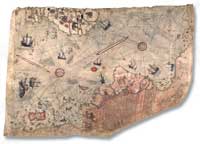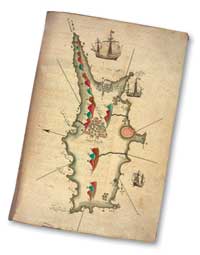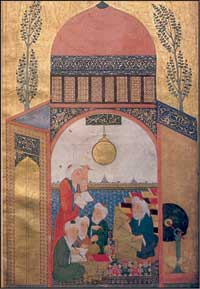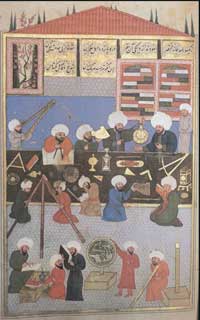1000 years of missing science Understand article
Yasmin Khan from the Science Museum in London, UK, reveals how deeply our modern civilisation has been enriched by previous Muslim civilisations – and argues for a more balanced approach to the history of science.

the Americas, by Piri Reis,
1513 CE
Image courtesy of FSTC
Isaac Newton, Charles Darwin and Albert Einstein. The chances are that if you try to remember which scientists you were taught about at school, these names will be on your list. But how many students will learn about scholars from non-Western civilisations, such as Ibn al-Haitham, a Muslim scholar of optics who first developed the laws of light reflection and invented the pinhole camera in the 11th century? Or Ibn Nafis, who first recorded observations on pulmonary blood circulation, a theory attributed to William Harvey 300 years later? How about Abbas ibn Firnas, who made the first attempt of human flight in the 9th century, using adjustable wings covered with feathers? And how many would know of Zeng He, the Chinese Muslim admiral who used refined technology to construct fleets of massive non-metal ship vessels five centuries ago?
Many are unaware of the extent to which our modern civilisation has been enriched by a series of past great civilisations, which include a largely unacknowledged and untaught Muslim heritage. This heritage has become part of European mainstream culture over the centuries and is manifest, for example, in our treasured architectural icons such as the dome of St Paul’s Cathedral in London, UK, and in the horseshoe arches and gothic ribs of Al-Hambra in Granada, Spain.

by Piri Reis
Image courtesy of FSTC
Even the way we speak shows the influence of languages from other cultures: many English words used in science, such as alchemy, algorithm, alkali, amalgam and zero, have their roots in the Arabic language and are a small demonstration of the cultural interconnectivity that has enriched Western civilisation over many centuries. The history of astronomy also reveals conspicuous examples of Muslim influences, such as in the naming of stars. Betelgeuse, Rigel, Vega, Aldebaran and Fomalhaut are among the names that are directly Arabic in origin or are Arabic translations of Ptolemy’s Greek descriptions. Other terms, such as azimuth (al-sumut), nadir (nazir), and zenith (al-samt), are also derived from Arabic.
The discoveries described above were made during a period commonly misconstrued in history textbooks as the Dark Ages. In fact, in the Muslim world, the period from circa 600-1600 CE was a prolific era of creative enquiry into science, technology and engineering and a time of advancement in civilisation, which would later act as a catalyst for the Western Renaissance. Amongst European scholars who were profoundly influenced and inspired by Muslim scholars were Roger Bacon, Leonardo da Vinci, Kepler, Michelangelo, Copernicus, Andreas Veselius and Galileo.
There has been much study of Muslim contributions to science and civilisation, yet research findings have until recently been confined to academia, a major barrier for teachers and students who seek easy-to-understand material. Four years ago, the UK-based Foundation for Science, Technology and Civilisation (FSTC), began a mission to popularise the Muslim contributions to civilisation through its Muslim heritage websitew1. For the first time, thanks to the Internet, information about this neglected period of history was readily and freely accessible to the wider public. The website has rapidly become a popular source for information on the Muslim contribution to science and a key resource for teachers and educators who wish to incorporate links to the history of science in their lessons.
After the launch of the website, the demand for more materials and resources on the subject increased rapidly. To address this gap, a touring, interactive educational exhibition was developed on Muslim scientific and technological discoveries, contributions and inventions. This exhibition, entitled 1001 Inventionsw2, was launched in the UK at the Museum of Science and Industry in Manchesterw3 earlier this year.

miniature showing students
studying astronomy with
their teacher, reading
measurements from an
astrolabe. From the 15th
century Persian manuscript
number 1418 in the
University Library, Istanbul,
Turkey
Image courtesy of FSTC
For the first time, museum visitors, including vast numbers of school groups, had the opportunity to discover innovations from Muslim heritage, many of which still have an impact on our lives. These range from the discovery of coffee as a recreational beverage to the development of sophisticated mechanical devices, as well as basic jet propulsion and rockets. We could all learn much from the Muslim scientists, scholars, polymaths and pioneers of the past, such as the 10th century medic Abul Qasim Al-Zahrawi (known in the West as Abulcasis) who dedicated his life to a multitude of indispensable inventions and innovations that still benefit humanity today. His discoveries include the use of catgut in surgery such as caesarean sections and an array of surgical instruments, including the forceps used in childbirth.
A favourite part of the exhibition is a picturesque manuscript illustrating Muslim astronomers working in a 16th century Turkish observatory, clad in traditional robes, turbans and beards. These men are forgotten role models: dutifully star-gazing, making and recording observations, taking precise measurements and performing scientific experiments as a sincere expression of their faith, searching for knowledge to benefit humanity.
Such was the degree of altruism and philanthropy that the golden age of Islamic science lasted for more than 1000 years. There is much debate about what caused the decline of this period in the 17th century, but we would benefit from encouraging students, Muslim and non-Muslim alike, to draw inspiration from this rich civilisation and heritage.
I once overheard a science teacher describing the complaints of her students: they were bored with being taught about scientists who were mostly men and of Anglo origin. This is symptomatic of the existing orthodoxy, which views history and science with a Eurocentric lens, ignoring contributions from other civilisations. Teachers recognise the importance to a student’s development of accessible role models to identify with and relate to. Young female students who aspire to careers in science, particularly those of ethnic origins, could find inspiration from unsung heroines of the past. For instance, Miriam al-Ijli al-Astrulabi, who hand-crafted intricate astrolabes, an early type of global positioning system, or entrepreneur Fatima al-Fihri, who in the 9th century founded the world’s oldest university in Morocco.

16th-century astronomers
working in the observatory
of Muradd III in Istanbul.
From the Shahansani-namah,
16th century, manuscript
number FY 1404 in the
University Library, Istanbul,
Turkey
Image courtesy of FSTC
Initiatives such as the 1001 Inventions project can encourage young people to participate in and contribute to society. These programmes can have a lasting and positive impact on this and the next generation of entrepreneurs, scientists, engineers and doctors from all communities. The current exhibition has already shown the positive outcomes of constructive representations of historical Muslim achievement. In June 2006, journalist David Bocking, who shadowed a school group visit to the 1001 Inventions exhibition, reported in the UK’s Times Educational Supplement the poignant comments of a young Muslim boy:
“This has taught us a lot,” said Hassan Zaffar. “I’m a Muslim and it gives me inspiration. It makes you look up to these people, and feel proud of them. It makes you want to go and do something like that yourself.”
Educators and policy-makers are gradually realising the need for a more accurate and inclusive account of the history of science as part of school education, which includes an appreciation of the contributions of civilisations that excelled long before our own. The future challenge will be for science curriculum developers to find ways of integrating this into mainstream school science lessons.
Instilling our children with a more inclusive and balanced world-view through our education system is fundamental to maintaining a harmonious co-existence in our society. A shift towards a more balanced account of the history of science is a step in the right direction. Students might thrive if they are exposed to ideas and knowledge that will help to cultivate their identity and to remind them of the different legacies that have shaped their world. These legacies include a shared and rich Muslim heritage, still visible in Europe and the rest of the world. This particular heritage might have been largely forgotten, but is now being rediscovered by all those with an interest in human civilisation and progress.
Web References
- w1 – The Muslim Heritage website is an online education community that brings together Muslims and non-Muslims seeking to advance civilisation through the study of our Muslim heritage
- w2 – An extensive website containing much of the information from the 1001 Inventions exhibition is available here: www.1001inventions.com
- w3 – Information about the Museum of Science and Industry in Manchester is available here: http://msimanchester.org.uk/
Resources
- The Foundation for Science Technology and Civilisation is a not-for-profit organisation which seeks to popularise the Muslim contribution to the West
- 1001 Inventions was displayed at the Museum of Science and Industry in Manchester until 3 September 2006 and will tour the UK and Europe. For more information and to download a free teacher’s pack, endorsed by the British Association for the Advancement of Science, visit: www.1001inventions.com
- A supporting book is also available for purchase: Al-Hassani S (2006) 1001 Inventions: Muslim Heritage in Our World. Manchester, UK: FSTC. ISBN: 09555242606
Review
This article is interesting to and appropriate for science teachers working with students of all ages. There is little of the history of science integrated into science lessons (certainly in the UK), and it is an area in which many teachers have limited subject knowledge. This article helps teachers think beyond the regular scientists that most students will have come across.
Further information, and interesting stories about these Muslim scientists would be a great help. The 1001 Inventions website has an excellent teacher’s pack allowing discussion of Muslim scientists to be brought into everyday science topics, such as acids and alkalis, light and pressure, through a series of lesson plans. As the lesson plans include such regularly used science topics, it will be easy to fit these into a busy timetable. However, don’t try to download the resources if you don’t have a broadband Internet connection.
Sam Hollis, UK





